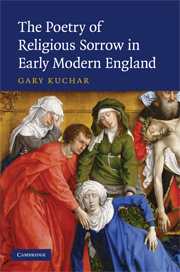Book contents
- Frontmatter
- Contents
- Acknowledgments
- Abbreviations and notes on texts
- Introduction: Of Sighs and Tears
- Chapter 1 The poetry of tears and the ghost of Robert Southwell in Shakespeare's Richard II and Milton's Paradise Lost
- Chapter 2 The poetry of tears and the metaphysics of grief: Richard Crashaw's “The Weeper”
- Chapter 3 The poetry of tears and the metaphysics of grief: Andrew Marvell's “Eyes and Tears”
- Chapter 4 Sad delight: Theology and Marian iconography in Aemilia Lanyer's Salve Deus Rex Judaeorum
- Chapter 5 Petrarchism and repentance in John Donne's Holy Sonnets
- Chapter 6 John Donne and the poetics of belatedness: Typology, trauma, and testimony in An Anatomy of the World
- Conclusion
- Index
- References
Chapter 3 - The poetry of tears and the metaphysics of grief: Andrew Marvell's “Eyes and Tears”
Published online by Cambridge University Press: 22 September 2009
- Frontmatter
- Contents
- Acknowledgments
- Abbreviations and notes on texts
- Introduction: Of Sighs and Tears
- Chapter 1 The poetry of tears and the ghost of Robert Southwell in Shakespeare's Richard II and Milton's Paradise Lost
- Chapter 2 The poetry of tears and the metaphysics of grief: Richard Crashaw's “The Weeper”
- Chapter 3 The poetry of tears and the metaphysics of grief: Andrew Marvell's “Eyes and Tears”
- Chapter 4 Sad delight: Theology and Marian iconography in Aemilia Lanyer's Salve Deus Rex Judaeorum
- Chapter 5 Petrarchism and repentance in John Donne's Holy Sonnets
- Chapter 6 John Donne and the poetics of belatedness: Typology, trauma, and testimony in An Anatomy of the World
- Conclusion
- Index
- References
Summary
If Crashaw reworks Herbert's “Grief” by substituting a poetics of difference for a Eucharistic poetics of similitude, then Andrew Marvell's “Eyes and Tears” responds to “The Weeper” by furthering the Calvinist ethos of The Temple. In the process, Marvell sums up the poetry of tears as a genre from a more discernibly Protestant viewpoint, giving the coincidence of “eyes and tears” a very different theological valence than their “kind contrarietyes” possess in Crashaw's “The Weeper.”
Although Marvell's “Eyes and Tears” revises the poetry of tears as a genre, it is often seen as only marginally participating in the tradition of Southwell's St Peters Complaint and Crashaw's “The Weeper.” For example, in his 2003 edition of Andrew Marvell's English poems, Nigel Smith glosses the subject matter of “Eyes and Tears” as secular with the proviso that stanza 8's description of Mary Magdalene is religious:
Marvell's poem begins and remains secular in subject-matter, like other similar examples in the period: see, e.g. Thomas Carew, “Lips and Eyes” (1640). Only stanza VIII, with the attached Latin version, is religious and certainly may be regarded as part of the English tradition inaugurated by the Elizabethan Jesuit Robert Southwell.
Smith's account of “Eyes and Tears,” one shared by other Marvell scholars, is inadequate not only because it begs the question of the poem's thematic integrity, but also because it elides how the poem revises the theological and devotional vision expressed in “The Weeper” and other more avowedly Catholic tear poems, especially William Alabaster's Spiritual Sonnets.
- Type
- Chapter
- Information
- The Poetry of Religious Sorrow in Early Modern England , pp. 99 - 123Publisher: Cambridge University PressPrint publication year: 2008



